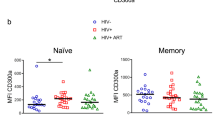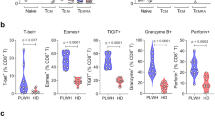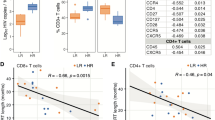Abstract
CD8-positive T cells are thought to play an important role in the control of infection by human immunodeficiency virus (HIV) as a result of their cytotoxic activity and by releasing soluble factors1,2. In AIDS patients, the absolute number of CD8+ T lymphocytes is decreased in peripheral blood3,4 and their turnover rate is increased, suggesting that there is more cell renewal and cell death occurring5. Anti-retroviral therapy raises CD8+ T-cell counts in HIV-infected patients6,7,8. Here we report that the death rate of CD8+ T cells by apoptosis increased markedly during HIV infection of peripheral blood mononuclear cells in vitro. Apoptosis is induced in a dose-dependent manner by recombinant envelope glycoprotein gp120 from HIV strain X4, or by stromal-derived factor-1 (SDF-1), the physiological ligand of the chemokine receptor CXCR4. Apoptosis is mediated by the interaction between tumour-necrosis factor-α bound to the membrane of macrophages (mbTNF) and a receptor on CD8+ T cells (TNF-receptor II, or TNFRII). The expression of both of these cell-surface proteins is upregulated by HIV infection or by treatment with recombinant gp120 or SDF-1. Apoptosis of CD8+ T cells isolated from HIV-infected patients is also mediated by macrophages through the interaction between mbTNF and TNFRII. These results indicate that the increased turnover of CD8+ T cells in HIV-infected subjects is mediated by the HIV envelope protein through the CXCR4 chemokine receptor.
This is a preview of subscription content, access via your institution
Access options
Subscribe to this journal
Receive 51 print issues and online access
$199.00 per year
only $3.90 per issue
Buy this article
- Purchase on Springer Link
- Instant access to full article PDF
Prices may be subject to local taxes which are calculated during checkout





Similar content being viewed by others
References
Cocchi, F.et al. Identification of RANTES, MIP-1α and MIP-1β as the major HIV-suppressive factors produced by CD8+ T cells. Science 270, 1811–1815 (1995).
Levy, J. A., Mackewicz, C. E. & Barker, E. Controlling HIV pathogenesis: the role of the noncytotoxic anti-HIV response of CD8+ T cells. Immunol. Today. 17, 217–224 (1996).
Meyaard, L.et al. Programmed death of T cells in HIV-1 infection. Science 257, 217–219 (1992).
Margolick, J. B.et al. Failure of T-cell homeostasis preceding AIDS in HIV-1 infection. The Multicenter AIDS Cohort Study. Nature Med. 1, 674–680 (1995).
Wolthers, K. C.et al. Tcell telomere length in HIV-1 infection: no evidence for increased CD4+ T cell turnover. Science 274, 1543–1547 (1996).
Mackewicz, C. E., Landay, A., Hollander, H. & Levy, J. A. Effect of zidovudine therapy on CD8+ T cell anti-HIV activity. Clin. Immunol. Immunopathol. 73, 80–87 (1994).
Sarin, A.et al. Inhibition of activation-induced programmed cell death and restoration of defective immune responses of HIV+ donors by cysteine protease inhibitors. J. Immunol. 153, 862–872 (1994).
Pakker, N. G.et al. Biphasic kinetics of peripheral blood T cells after triple combination therapy in HIV-1 infection: a composite of redistribution and proliferation. Nature Med. 4, 208–214 (1998).
Herbein, G., Van Lint, C., Lovett, J. L. & Verdin, E. Distinct mechanisms trigger apoptosis in human immunodeficiency virus type 1-infected and in uninfected bystander T lymphocytes. J. Virol. 72, 660–670 (1998).
Wu, M. X., Daley, J. F., Rasmussen, R. A. & Schlossman, S. F. Monocytes are required to prime peripheral blood T cells to undergo apoptosis. Proc. Natl Acad. Sci. USA 92, 1525–1529 (1995).
Collin, M., Illei, P., James, W. & Gordon, S. Definition of the range and distribution of human immunodeficiency virus macrophage tropism using PCR-based infectivity measurements. J. Gen. Virol. 75, 1597–1603 (1994).
Simmons, G.et al. Primary, synctium-inducing human immunodeficiency virus type 1 isolates are dual-tropic and most can use either Lestr or CCR5 as coreceptors for virus entry. J. Virol. 70, 8355–8360 (1996).
Feng, Y., Broder, C. C., Kennedy, P. E. & Berger, E. A. HIV-1 entry cofactor: functional cDNA cloning of a seven-transmembrane, G protein-coupled receptor. Science 272, 872–877 (1996).
Bleul, C. C.et al. The lymphocyte chemoattractant SDF-1 is a ligand for LESTR/fusin and blocks HIV-1 entry. Nature 382, 829–833 (1996).
Choe, H.et al. The β-chemokine receptors CCR3 and CCR5 facilitate infection by primary HIV-1 isolates. Cell 85, 1135–1148 (1996).
Doranz, B. J.et al. Adual-tropic primary HIV-1 isolate that uses fusin and the beta-chemokine receptors CKR-5, CKR-3, and CKR-2b as fusion cofactors. Cell 85, 1149–1158 (1996).
Effros, R. B. & Pawelec, G. Replicative senescence of T cells: does the Hayflick Limit lead to immune exhaustion? Immunol. Today. 18, 450–454 (1997).
Heller, R. A., Song, K., Fan, N. & Chang, D. J. The p70 tumor necrosis factor receptor mediates cytotoxicity. Cell 70, 47–56 (1992).
Zheng, L.et al. Induction of apoptosis in mature T cells by tumour-necrosis factor. Nature 377, 348–351 (1995).
Grynkiewicz, G., Poenie, M. & Tsien, R. Y. Anew generation of Ca2+ indicators with greatly improved fluorescence properties. J. Biol. Chem. 260, 3440–3450 (1985).
Schuitemaker, H.et al. Biological phenotype of human immunodeficiency virus type 1 clones at different stages of infection: progression of disease is associated with a shift from monocytotropic to T-cell-tropic virus population. J. Virol. 66, 1354–1360 (1992).
Koot, M.et al. Prognostic value of HIV-1 syncytium-inducing phenotype for rate of CD4+ cell depletion and progression to AIDS. Ann. Intern. Med. 118, 681–688 (1993).
Daar, E. S.et al. Sequential determination of viral load and phenotype in human immunodeficiency virus type 1 infection. AIDS Res. Hum. Retrovir. 11, 3–9 (1995).
Connor, R. I. & Ho, D. D. Human immunodeficiency virus type 1 variants with increased replicative capacity develop during the asymptomatic stage before disease progression. J. Virol. 68, 4400–4408 (1994).
Phillips, R. E.et al. Human immunodeficiency virus genetic variation that can escape cytotoxic T-cell recognition. Nature 354, 453–459 (1991).
Feinberg, M. B. & McLean, A. R. AIDS: decline and fall of immune surveillance? Curr. Biol. 7, R136–R140 (1997).
Acknowledgements
We thank C. Amella for help with RT assays; D. Schepp for blood from HIV-infected patients; M. Grell, J. Nichols, N. Roberts, H. Schmidmayerova and B. Sherry for discussion; N. Shea for graphics; G. Howard and S. Ordway for editing the manuscript; and the AIDS Research and Reference Reagent Program (NIAID, NIH, PHS) for reagents. This work was supported in part by grants from the NIH of the US Public Health Service (to E.V.), by institutional funds from the Picower Institute for Medical Research, the University of Texas Medical Branch, and the Gladstone Institute of Virology and Immunology.
Author information
Authors and Affiliations
Corresponding author
Rights and permissions
About this article
Cite this article
Herbein, G., Mahlknecht, U., Batliwalla, F. et al. Apoptosis of CD8+ T cells is mediated by macrophages through interaction of HIV gp120 with chemokine receptor CXCR4. Nature 395, 189–194 (1998). https://doi.org/10.1038/26026
Received:
Accepted:
Issue Date:
DOI: https://doi.org/10.1038/26026
This article is cited by
-
HIV-1 envelope glycoprotein stimulates viral transcription and increases the infectivity of the progeny virus through the manipulation of cellular machinery
Scientific Reports (2017)
-
Endocytic Trafficking of HIV gp120 is Mediated by Dynamin and Plays a Role in gp120 Neurotoxicity
Journal of Neuroimmune Pharmacology (2017)
-
Effect of Cocaine on HIV Infection and Inflammasome Gene Expression Profile in HIV Infected Macrophages
Scientific Reports (2016)
-
Tuning of AKT-pathway by Nef and its blockade by protease inhibitors results in limited recovery in latently HIV infected T-cell line
Scientific Reports (2016)
-
Apoptosis and frequency of total and effector CD8+ T lymphocytes from cutaneous leishmaniasis patients during antimonial therapy
BMC Infectious Diseases (2015)
Comments
By submitting a comment you agree to abide by our Terms and Community Guidelines. If you find something abusive or that does not comply with our terms or guidelines please flag it as inappropriate.



